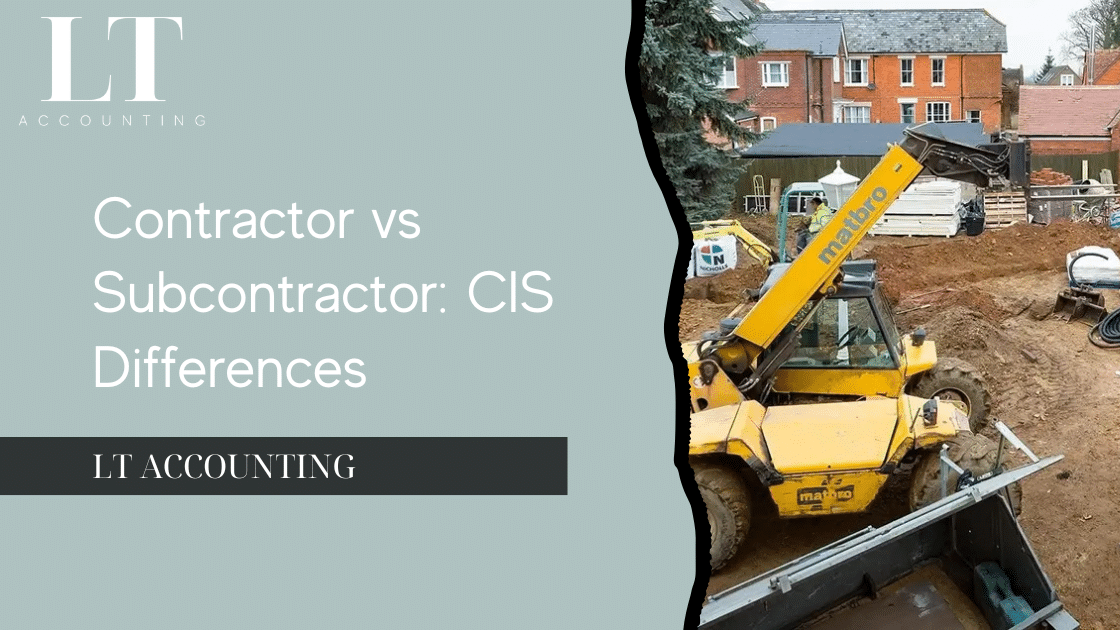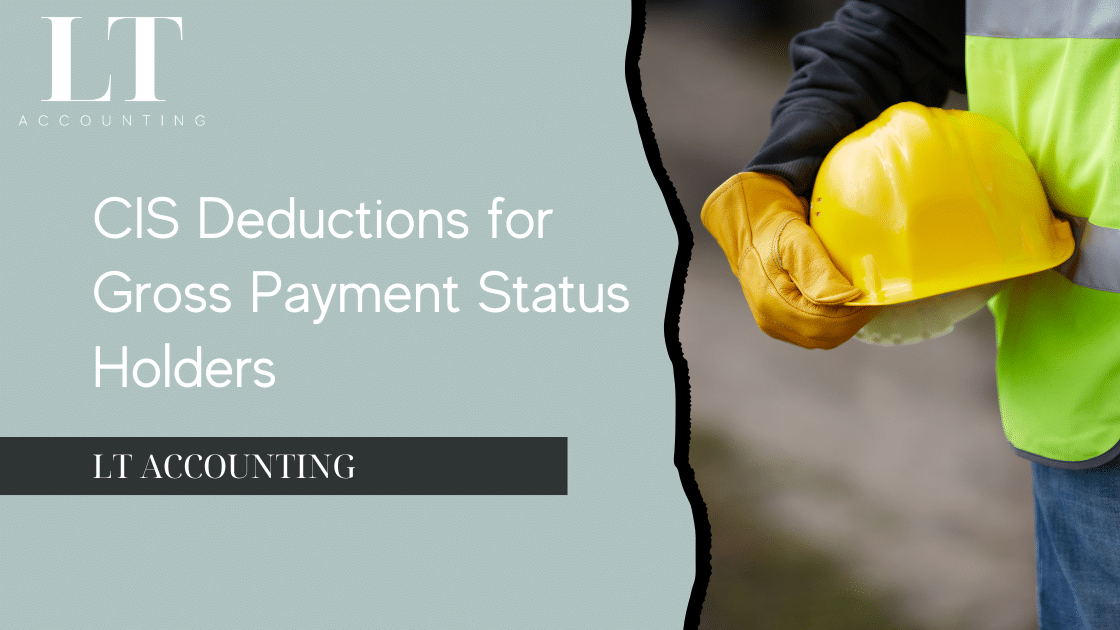Introduction: Navigating the Construction Industry Scheme (CIS)
If you operate in the UK construction sector—whether as a contractor or subcontractor—understanding the Construction Industry Scheme (CIS) is essential for staying compliant with HMRC rules. The CIS is a tax deduction scheme that requires contractors to withhold tax from payments to subcontractors and pay this directly to HM Revenue and Customs. But the question many contractors face is: when exactly are you required to deduct CIS from payments?
It’s not always straightforward. There are rules around who qualifies as a contractor, what kind of work falls under CIS, and whether a subcontractor’s tax status affects the deduction amount. Making mistakes with CIS—whether by deducting incorrectly, deducting too much or too little, or failing to deduct at all—can result in serious penalties and cash flow issues.
This comprehensive guide from LT Accounting will walk you through everything you need to know about when to deduct CIS, when not to, and how to ensure accurate and compliant payments to subcontractors.
What is the Construction Industry Scheme (CIS)?
The Construction Industry Scheme was introduced by HMRC to improve tax compliance in the construction sector, where historically there had been significant issues with undeclared income. The scheme ensures that a portion of a subcontractor’s earnings is taxed at source, helping HMRC collect income tax and National Insurance contributions more reliably.
Who Does CIS Apply To?
CIS applies to:
-
Contractors: Businesses (including sole traders, partnerships, and companies) that pay subcontractors for construction work. If you spend more than £3 million on construction within 12 months, even if you’re not in the construction industry, you’re deemed a contractor and must operate CIS.
-
Subcontractors: Workers or businesses that are paid to carry out construction work for a contractor. This includes sole traders, partnerships, and limited companies.
It’s worth noting that businesses can be both contractors and subcontractors under CIS depending on their role in a project.
What Work is Covered?
The scheme covers a wide range of construction-related activities, including:
-
Site preparation
-
Alterations
-
Dismantling
-
Building work
-
Repairs
-
Decorating
-
Demolition
CIS does not apply to:
-
Architecture and surveying
-
Scaffolding hire (with no labour)
-
Carpet fitting
-
Material supply only (more on this later)
-
Work carried out outside the UK
Why It’s Crucial to Understand CIS Deductions
Failing to understand when to deduct CIS can lead to:
-
Penalties from HMRC for incorrect reporting
-
Overpayments to subcontractors that you can’t easily recover
-
Cash flow problems from paying out more than you should
-
Loss of gross payment status for subcontractors if deductions are misreported
-
Damaged business relationships from disputes over payment amounts
As a contractor, it is your legal duty to:
-
Register with HMRC for CIS
-
Verify your subcontractors’ tax status
-
Deduct tax at the correct rate
-
Provide payment and deduction statements to subcontractors
-
File monthly CIS returns
At LT Accounting, we support contractors through every stage of CIS compliance, offering tailored services to handle CIS returns, subcontractor verification, deduction statements, and HMRC submissions.
When Are CIS Deductions Required?
Understanding the specific circumstances under which Construction Industry Scheme (CIS) deductions are mandated is crucial for contractors operating within the UK construction sector. Ensuring compliance with HM Revenue and Customs (HMRC) regulations not only avoids potential penalties but also fosters transparent and efficient financial operations.
Key Conditions Triggering CIS Deductions
As a contractor, you are obligated to deduct CIS from payments to subcontractors when the following conditions are met:
-
Engagement in Construction Work: The payment is made for construction operations as defined by HMRC.
-
Subcontractor Relationship: The individual or entity receiving the payment operates as a subcontractor, not as an employee.
-
Location of Work: The construction work is performed within the UK.
It is imperative to correctly identify the nature of the work and the status of the worker to determine the applicability of CIS deductions.
Verifying Subcontractor Status with HMRC
Before processing any payments, contractors must verify the subcontractor’s status with HMRC to ascertain the correct deduction rate. This verification process involves:
-
Gathering Subcontractor Information: Obtain the subcontractor’s Unique Taxpayer Reference (UTR), National Insurance number (for sole traders), or company registration number (for limited companies).
-
Using HMRC’s Verification Service: Utilize HMRC’s online services or commercial CIS software to submit the subcontractor’s details.
-
Receiving Deduction Instructions: HMRC will confirm whether the subcontractor is registered and indicate the applicable deduction rate.
This verification ensures that deductions are made accurately and in compliance with HMRC guidelines.
Standard CIS Deduction Rates
Based on the subcontractor’s registration status, the CIS deduction rates are as follows:
-
20% Standard Rate: Applied to payments made to subcontractors who are registered with HMRC for CIS.
-
30% Higher Rate: Applied under the following circumstances:
-
The subcontractor’s verification details cannot be confirmed.
-
Incorrect information is provided during verification.
-
0% Gross Payment Status: No deductions are made if the subcontractor has been granted gross payment status by HMRC, meaning they receive full payment without any deductions.
Ensuring the correct deduction rate is applied is vital for maintaining compliance and avoiding potential disputes or penalties.
Obligations Following Deductions
After making the appropriate deductions:
-
Remit Deductions to HMRC: Contractors must pay the deducted amounts to HMRC by the 22nd of each month (or the 19th if paying by post) following the month in which the payment was made.
-
Provide Payment and Deduction Statements: Subcontractors should receive a statement detailing the gross amount, deductions made, and net payment, typically within 14 days of the end of the tax month.
Adhering to these obligations ensures transparency and assists subcontractors in managing their tax affairs effectively.
When Not to Deduct CIS
While the Construction Industry Scheme (CIS) outlines clear scenarios in which contractors must deduct tax from payments to subcontractors, it’s equally important to understand when deductions are not required. Failing to recognise these exemptions can lead to over-deductions, strained subcontractor relationships, and unnecessary administrative burdens.
Here’s a breakdown of the main situations in which CIS does not apply or where deductions should not be made:
1. Payments for Materials Only
If a subcontractor issues an invoice for materials alone—with no associated labour or construction services—CIS does not apply.
Example:
-
A subcontractor supplies bricks and cement but does not carry out any construction work.
-
In this case, the entire payment is exempt from CIS deductions.
However, if materials are supplied as part of a labour-inclusive contract, only the labour portion of the invoice is subject to deduction. This requires accurate allocation of costs by the subcontractor on their invoice. HMRC expects contractors to make reasonable assessments where necessary.
Contractor Tip: Always request detailed breakdowns in invoices so that you can distinguish between the cost of materials and labour. LT Accounting can help ensure that your deductions are calculated on the correct figures, protecting you from HMRC scrutiny.
2. Subcontractors with Gross Payment Status
Subcontractors who have successfully applied for and been granted gross payment status by HMRC are paid in full—with no CIS deductions.
To qualify for gross payment status, a subcontractor must:
-
Be registered with HMRC for CIS
-
Demonstrate a good record of tax compliance
-
Meet turnover thresholds: e.g., a sole trader must earn at least £30,000 annually (higher thresholds apply to partnerships and companies)
As a contractor, you must still verify the subcontractor’s status with HMRC. If they are confirmed as having gross payment status, you should not make any CIS deductions.
3. VAT Should Not Be Subject to CIS
If a subcontractor is VAT-registered, the VAT element of the invoice should not be included when calculating CIS deductions. This rule prevents tax being deducted from another tax.
Example:
-
Subcontractor invoice: £1,000 labour + £200 VAT = £1,200 total
-
CIS is applied only to the £1,000 labour (assuming no material costs are claimed)
You should still make sure the subcontractor is genuinely VAT-registered and charging VAT correctly. Mistakes in this area could lead to incorrect deductions or problems with HMRC.
4. Work Not Covered by CIS
Not all construction-related work falls within the scope of CIS. Deductions are not required if the service falls outside of the scheme’s remit.
Some common examples of excluded work include:
-
Professional services such as architecture, surveying, or engineering
-
Delivery of materials (unless part of a construction contract)
-
Scaffolding hire (where no labour is provided to erect it)
-
Carpet fitting
-
Work outside the UK
If a subcontractor provides these services only, you do not need to verify them with HMRC or deduct CIS. However, if they perform both included and excluded activities, only the CIS-relevant portion is subject to deduction.
5. Payments to Employees
CIS does not apply to employees. If a worker is classed as an employee (not self-employed), you must pay them through PAYE, not under CIS. HMRC has strict rules and tests (like the Employment Status Manual) to determine employment status, and misclassification can lead to penalties.
If in doubt, seek guidance from an accountant—misclassifying a subcontractor as self-employed under CIS when they should be an employee under PAYE can result in backdated taxes and fines.
Avoiding Unnecessary Deductions with LT Accounting
It can be tricky to determine when a payment falls under CIS—especially with mixed invoices or borderline work types. LT Accounting provides bespoke advice and full CIS return services to ensure that:
-
Deductions are only made when required
-
Your business complies with HMRC guidance
-
You avoid penalties and maintain subcontractor trust
Our services cover contractor CIS obligations, CIS statement generation, monthly returns, and assistance with subcontractor verification.
How to Calculate CIS Deductions Accurately
One of the most crucial responsibilities for contractors under the Construction Industry Scheme (CIS) is ensuring CIS deductions are calculated correctly. This isn’t just about applying the right percentage — it involves understanding what parts of the payment are subject to deduction, correctly handling VAT and material costs, and ensuring everything aligns with HMRC regulations.
Getting these calculations wrong can result in:
-
Overpayments to HMRC
-
Underpayments that may incur penalties
-
Frustrated subcontractors
-
Compliance issues that trigger audits
In this section, we break down the calculation process step-by-step, with real-world examples to illustrate the correct method.
Step 1: Determine the Gross Payment Amount
The gross payment is the total amount due to the subcontractor before any deductions are made, excluding any costs that are exempt from CIS — such as VAT and allowable materials.
A typical subcontractor invoice might look like this:
| Description | Amount |
|---|---|
| Labour | £1,500 |
| Materials | £500 |
| VAT @ 20% | £400 |
| Total Invoice | £2,400 |
Step 2: Exclude VAT from the Deduction Calculation
Under HMRC rules, CIS deductions are not applied to VAT, even if it is included on the invoice. VAT must be completely excluded from the amount used for the CIS calculation.
So, from the above example:
-
Total invoice: £2,400
-
Deduct VAT: £400
-
Subtotal: £2,000
Step 3: Exclude the Cost of Materials (If Clearly Itemised)
You can exclude materials from the deduction only if they are clearly listed and reasonable in cost. The contractor must be confident that:
-
The materials were purchased directly by the subcontractor
-
The amount claimed represents actual costs (not profit or mark-up)
-
The subcontractor is not charging for labour or other services under the guise of materials
So, continuing the example:
-
Subtotal after VAT: £2,000
-
Deduct materials: £500
-
CIS-deductible labour: £1,500
Step 4: Apply the Correct CIS Rate
Depending on the subcontractor’s status (as verified with HMRC), apply the correct deduction rate:
-
20% for registered subcontractors
-
30% for unverified or non-registered subcontractors
-
0% for those with gross payment status
Example Calculation (20% rate):
-
Deductible labour amount: £1,500
-
CIS Deduction: £1,500 × 20% = £300
Step 5: Make the Net Payment
Once the deduction is calculated, the net payment to the subcontractor is:
-
Total invoice: £2,400
-
Less CIS deduction: £300
-
Net payment to subcontractor: £2,100
The contractor must then:
-
Pay the subcontractor £2,100
-
Send £300 to HMRC
-
Provide the subcontractor with a deduction statement
Using CIS Software for Accuracy and Efficiency
Manual CIS calculations can be error-prone, especially when managing multiple subcontractors and payments each month. Many UK contractors now rely on CIS-enabled accounting or payroll software, which can:
-
Automate deduction calculations
-
Integrate subcontractor verification
-
Generate and submit CIS returns
-
Create payment & deduction statements automatically
At LT Accounting, we offer full support through cloud-based accounting systems that are CIS-compliant, HMRC-recognised, and tailored for UK construction firms. Whether you use Xero, QuickBooks, or a custom spreadsheet system, we can help you ensure:
-
Each deduction is calculated correctly
-
No VAT or ineligible costs are mistakenly included
-
Monthly reports are filed on time
Summary: What to Always Include and Exclude
| Cost Item | Include in CIS? |
|---|---|
| Labour | ✅ Yes |
| Materials (clearly itemised) | ❌ No |
| VAT | ❌ No |
| Plant hire with operator | ✅ Yes |
| Plant hire without operator | ❌ No |
| Accommodation or travel | ❌ No (usually) |
Reporting and Paying CIS Deductions to HMRC
Making the correct deductions under the Construction Industry Scheme (CIS) is only half the battle. The other half is reporting those deductions to HMRC accurately and on time — and ensuring payments are made without delay. Contractors who fall behind on this administrative side risk fines, interest charges, and even damage to their business reputation.
In this section, we’ll explain exactly what your obligations are, the monthly process for filing returns, payment methods, common pitfalls, and how LT Accounting can help you manage it all seamlessly.
Monthly CIS Returns – What Are They?
If you’re a contractor registered under CIS, you must submit a CIS300 return to HMRC every month, even if you haven’t made any payments to subcontractors during that period.
This return includes:
-
The name, UTR, and verification number of each subcontractor paid
-
The gross amount paid
-
The cost of any materials (if applicable)
-
The amount deducted
You must submit your CIS return by the 19th of each month, covering payments made in the previous tax month (6th to 5th).
Example:
-
Payments made between 6th March and 5th April must be reported by 19th April.
How to File Your CIS Return
There are three main ways to file your CIS returns:
-
Online via HMRC’s CIS service – through your Government Gateway account
-
Commercial CIS/accounting software – such as QuickBooks, Xero, or Sage
-
Through an accountant or tax agent – like LT Accounting
Using dedicated software or a qualified accountant reduces errors and saves time, especially if you’re handling multiple subcontractors.
Paying CIS Deductions to HMRC
In addition to filing the return, contractors must also pay the deducted amounts to HMRC by the 22nd of the month (or the 19th if paying by cheque/post).
So, if you deducted £300 from a subcontractor on 10th March, you must:
-
Report it in the April 19th CIS return
-
Pay the £300 to HMRC by 22nd April
Payments can be made via:
-
Online banking
-
Direct Debit
-
HMRC’s PAYE online service
Note: If you pay subcontractors through your PAYE scheme, you may combine CIS and PAYE payments into one total submission.
Penalties for Late or Incorrect Returns
HMRC takes CIS compliance very seriously. If you file your CIS return late, you will face automatic penalties:
| Delay Period | Penalty |
|---|---|
| 1 day late | £100 |
| 2 months late | £200 |
| 6 months late | £300 or 5% of deductions |
| 12 months late | £300 or 5% of deductions again |
| 12+ months with intent to mislead | Up to £3,000 or higher penalties |
These penalties apply per return, so if you’re several months behind, they can accumulate quickly. Mistakes in returns can also result in fines, so accuracy is critical.
Issuing CIS Payment and Deduction Statements
Contractors are also required to provide each subcontractor with a payment and deduction statement every month that they’re paid. This acts as a receipt showing:
-
Gross payment amount
-
Materials (if applicable)
-
CIS deduction amount
-
Net amount paid
-
HMRC verification reference (if applicable)
This document helps subcontractors claim their CIS deductions as a credit on their Self Assessment or Corporation Tax return.
Best practice: Issue these statements within 14 days of month-end.
Let LT Accounting Handle Your CIS Returns
Managing monthly CIS reporting, payments, and deductions can be time-consuming, especially for small contractors or those with several subcontractors. That’s where we step in.
LT Accounting provides a full-service CIS return solution, including:
-
Subcontractor verification
-
Deduction calculation
-
Monthly CIS300 filing
-
Deduction statement issuance
-
Payment scheduling reminders
-
Liaison with HMRC
By outsourcing your CIS obligations to us, you can avoid penalties, save hours in admin, and focus on what you do best — running your business.
Common CIS Mistakes and How to Avoid Them
Despite best intentions, many UK contractors fall foul of CIS rules due to simple oversights or misunderstandings. Unfortunately, these mistakes can lead to financial penalties, compliance issues, and damaged relationships with subcontractors and HMRC alike.
Here’s a breakdown of the most common errors contractors make under the Construction Industry Scheme — and how you can avoid them with the right knowledge and support.
1. Failing to Verify Subcontractors with HMRC
One of the most frequent and serious mistakes is paying a subcontractor without verifying them first through HMRC. Verification is essential to:
-
Determine the correct deduction rate (20%, 30%, or 0%)
-
Confirm they are registered under CIS
-
Avoid automatic higher-rate deductions
What happens if you skip verification?
-
You may deduct the incorrect amount
-
You could face penalties or queries from HMRC
-
Subcontractors may be unhappy if over-deducted (e.g., 30% instead of 20%)
Solution: Always verify each new subcontractor before making any payment. Use HMRC’s online CIS verification tool or accounting software that integrates this function.
2. Deducting CIS from VAT
Under CIS, you must not deduct tax from the VAT portion of a subcontractor’s invoice. Yet, many contractors mistakenly include the full invoice amount—including VAT—when calculating the deduction.
Example of what not to do:
-
Invoice: £1,000 labour + £200 VAT = £1,200
-
Incorrect deduction: 20% of £1,200 = £240 (wrong!)
-
Correct deduction: 20% of £1,000 = £200
Solution: Always exclude VAT when calculating CIS. If unsure, confirm whether the subcontractor is VAT-registered.
3. Deducting CIS from Materials
CIS should only be applied to the labour element of a payment. If materials are included on an invoice and clearly itemised, these should be excluded from the deduction calculation.
Common error: Applying CIS to the entire invoice, including materials.
Solution: Insist on detailed invoices from subcontractors showing a breakdown of labour, materials, and VAT. Only deduct from the labour portion (excluding VAT).
4. Missing CIS Return Deadlines
The CIS300 return must be filed by the 19th of each month, and payments to HMRC must be made by the 22nd. Missing either of these dates triggers automatic penalties, starting at £100 per late return and escalating quickly.
Solution: Use a CIS-compliant accountant like LT Accounting, or automated accounting software that sets reminders, flags due dates, and can file returns on your behalf.
5. Misclassifying Subcontractors as Self-Employed
CIS only applies to self-employed subcontractors. If someone you’ve hired actually works like an employee (set hours, tools provided, under your control), they may be classed as an employee for tax purposes — meaning they should be on PAYE, not CIS.
Risks of misclassification:
-
Backdated PAYE tax and NIC
-
Penalties and interest from HMRC
-
Legal disputes or employment claims
Solution: Use HMRC’s Employment Status for Tax (CEST) tool or speak to an accountant to assess the correct status before deciding how to pay a worker.
6. Forgetting to Issue Deduction Statements
Every subcontractor who has tax deducted must receive a payment and deduction statement. If you don’t issue one, the subcontractor:
-
Can’t claim back the tax
-
Might report your business to HMRC
-
May refuse to work with you again
Solution: Always issue a statement within 14 days of month-end. Use accounting software or work with LT Accounting to automate this process.
7. Relying on Guesswork for Material Costs
Some contractors “guess” or estimate material costs when they’re not clearly provided. This can cause:
-
Over-deductions if too low
-
HMRC disputes if unreasonable
Solution: Request accurate, itemised invoices from subcontractors. If in doubt, challenge the figures or contact your accountant.
Avoiding Mistakes with LT Accounting
At LT Accounting, we help clients avoid these costly and time-consuming errors by providing:
-
Subcontractor verification support
-
Accurate CIS deduction calculations
-
Automated filing of monthly CIS returns
-
Reminder systems for key deadlines
-
Full compliance checks and audits
Whether you’re a sole trader handling a few subcontractors or a limited company managing dozens, we ensure your CIS obligations are met correctly and efficiently — every time.
How LT Accounting Can Help with CIS Compliance
Managing CIS obligations as a contractor in the UK can be time-consuming, complex, and sometimes downright overwhelming — especially when paired with the day-to-day demands of running a construction business. Whether you’re a seasoned contractor or just taking on your first subcontractor, working with a specialist accountant can make all the difference.
At LT Accounting, we specialise in helping contractors across the UK construction industry manage CIS with total peace of mind. Our expert services are tailored to your needs, keeping your business compliant, efficient, and focused on what you do best: building.
Our CIS Services: End-to-End Contractor Support
We offer full-service CIS support to ensure every part of your process is HMRC-compliant, accurate, and streamlined. Here’s how we help:
✅ Subcontractor Verification
We handle the verification process with HMRC for each subcontractor you hire, ensuring the correct deduction rate is applied every time — 0%, 20%, or 30%.
✅ Accurate CIS Deduction Calculations
We make sure deductions are correctly applied:
-
Only on labour (excluding VAT and materials)
-
Based on clear, itemised invoices
-
With all data verified for compliance
We can work with your existing systems (like Xero, QuickBooks, Sage) or manage the process entirely for you.
✅ Monthly CIS300 Returns
We prepare and submit your monthly CIS returns on time, every time. Never miss another deadline or risk an HMRC penalty again.
✅ CIS Payment Statements
We produce and send HMRC-compliant deduction statements to each subcontractor, helping them reclaim their tax and keeping you transparent and professional.
✅ Payment Scheduling & Reminders
We ensure you’re always reminded of:
-
Return submission dates
-
Payment deadlines to HMRC
-
Any follow-up action required if a subcontractor’s status changes
✅ Dispute Resolution & Compliance Audits
Got a letter from HMRC? A disagreement with a subcontractor? Need to review historical CIS deductions? We’ll step in and sort it — fast.
We Go Beyond CIS: Construction-Focused Accounting Services
CIS is just one part of the bigger picture. At LT Accounting, we offer complete financial management solutions for UK contractors and construction businesses:
-
Bookkeeping: Real-time records, reconciliations, and expense tracking
-
Payroll: PAYE, RTI submissions, and pension compliance for all your staff
-
VAT Returns: Including flat-rate or standard schemes and construction-specific considerations
-
Management Accounts: Insightful monthly or quarterly reporting for better decision-making
-
Self-Assessments & Year-End Accounts: Personal and business returns prepared and filed
-
CIS Returns for Subcontractors: Helping subcontractors claim their CIS tax back promptly
-
Business Advice & Support: From sole trader to limited company transitions, tax planning, and more
Why Choose LT Accounting for CIS?
-
🚧 Specialists in Construction Accounting
-
🧾 CIS, VAT, and Payroll all in one place
-
✅ Fully HMRC-compliant processes
-
☁️ Cloud-based systems to keep you mobile and efficient
-
📞 Friendly, proactive support from real people who understand your trade
Whether you’re handling one subcontractor or twenty, we take the hassle out of CIS compliance — so you can focus on growing your business, not navigating red tape.
Conclusion: Be CIS-Smart with LT Accounting
To sum up, knowing when to deduct CIS is essential — but so is knowing how and when not to. With strict HMRC rules and a complex web of calculations, it’s easy to make a costly mistake. That’s why smart contractors turn to professional support.
LT Accounting is here to keep you compliant, confident, and in control. We offer comprehensive CIS management services, tailored accounting solutions, and a team that truly understands the unique demands of the construction industry.






